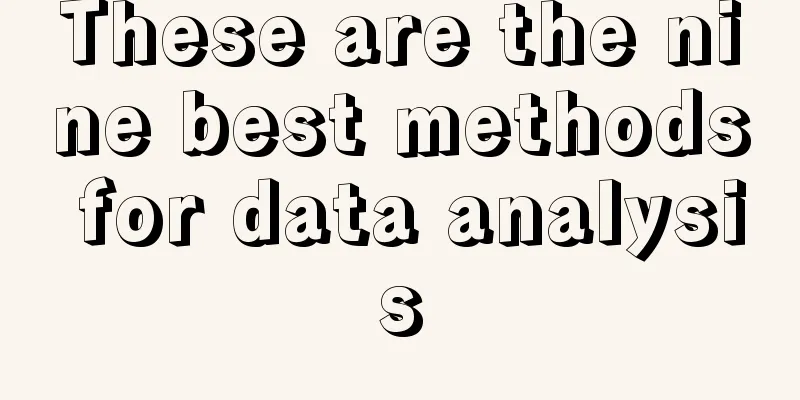These are the nine best methods for data analysis

01 What is the basic methodIn essence, almost all jobs are related to data and require some data analysis methods. However, data itself has a threshold. Many people were afraid of math classes when they were in school, not to mention complex theories. Therefore, the so-called basic data analysis method should be:
In short, the basic method is the one that everyone can use. Based on this concept, we have compiled nine basic analysis methods for you, which are simple and easy to use. 02 Start with an indicator1. Periodic analysis methodThe most basic analysis method can start with an indicator, which is the "periodic analysis method". The so-called "periodic analysis method" is very simple in operation, which is to extend the observation time of an indicator to see if it has a periodic change pattern. This method is simple to analyze, but very practical, because novices often make jokes because they don't know how to read the cycle changes. Such as: "I noticed that the indicator fell sharply yesterday" - Yesterday was the weekend, so it should have fallen (natural cycle changes) “I found that product A sells very well” – Product A has just been launched, so it should sell well (product life cycle) Often, the indicators we look at are overall indicators, which are composed of several parts, such as: Head office - Branch A, Branch B, Branch C Total sales - Product A, Product B, Product C Therefore, after seeing an overall indicator, you can break down the whole according to its components and understand the composition of each part. This is the structural analysis method (analyzing the internal structure of the whole). 2. Structural analysis methodThe structural analysis method is useful in many cases. For example, if you ask: "Why is the performance declining?" Answer: "Because XX area is not done well!" By looking at the structure, you can quickly find the person responsible. 3. Hierarchical analysis methodIn addition to simply looking at the structure, people also like to make rankings and distinguish between high, medium and low levels. This is the hierarchical analysis method. Many students confuse stratification and structure. Just remember the following two sentences: Structure exists objectively, just ask clearly. Stratification is subjective, and you need to determine the high and low. These three methods are the most basic of the basics. First, they are all analyzing an indicator. Second, they are all based on factual statements and do not require any calculations. When we first arrive at a company or come into contact with new data, we can use these three methods to establish basic cognition. 03 From one indicator to two indicators1. Matrix analysis methodWhen the number of indicators increases from one to two, the best method is matrix analysis. Matrix analysis constructs an analysis matrix by crossing two indicators, and uses the average value to cut out four quadrants to find problems (as shown below). The biggest advantage of the matrix analysis method is that it is intuitive and easy to understand. It is easy to find problems from the cross-comparison of two indicators. Especially when the two indicators are input/cost indicators, the two categories of high cost + low income and low cost + high income can directly indicate the direction of improvement for the business, thus greatly avoiding the problem of "not knowing how to evaluate good and bad". Many consulting companies like to use this method, which is similar to the KANO model or the Boston Matrix. The essence is to find two good evaluation indicators, construct a matrix by cross-constructing the two indicators, and classify the business. The classification effect is very good, so it is widely circulated. 04 From 2 indicators to multiple indicatorsWhen there are more analytical indicators, the most important task is to figure out the relationship between these indicators. There are two typical relationships. 1. The first type: parallel relationshipSeveral indicators are independent of each other and are components of the upper-level indicators. For example, we often say: Performance = Number of customers * Consumption rate * Average customer price In this formula
At this point, the number of customers, consumption rate, and average order value are three parallel indicators, and are all sub-indicators of performance. 2. The second type: serial relationshipSeveral indicators are interrelated and have a sequential relationship. For example, we often say: Number of new registered users = number of ad viewers * landing page conversion rate * registration page conversion rate.
At this point, the indicators of the advertising page, landing page, and registration page are interrelated, and users have to proceed step by step. These two relationships correspond to two basic analysis methods: Parallel relationship: indicator decomposition method, by decomposing a first-level indicator, problems can be found from the second-level indicators. Funnel analysis method: By observing a series of processes, understand the process conversion rate and find out the shortcoming of the conversion rate. 3. Indicator decomposition methodThe indicator decomposition method is generally used more in business analysis. For example, a small program mall had sales of 1.5 million last month and 1.2 million this month. If you only look at the results, you will not know anything except that there is a loss of 300,000. However, after the indicator is decomposed, you can find a lot of things (as shown below) After breaking it down, it is obvious that although the number of registered users increased this month, the consumption rate dropped significantly, so the income was less. In the future, we can further think about how to increase the consumption rate. 4. Funnel analysisThe funnel analysis method is more commonly used in Internet product/promotion/operation analysis, because Internet products can record more user data, and thus can present the entire user conversion process for analysis. For example, when we see a product advertisement online, we are very interested and click to buy it. We need to go through the steps of advertisement page → details page → shopping cart → payment. With each additional step, some users will be lost, just like a funnel. At this point, you can use a conversion funnel to graphically represent this relationship (as shown below). With the conversion funnel, we can further analyze the funnel to guide business improvements:
5. Correlation analysisOf course, there are some indicators that may not have a direct parallel/serial relationship, but at work, I would also like to know if they are related, such as:
At this point, you need to master the correlation analysis method. Note: There may be a natural correlation between indicators. Common natural correlations have three forms:
These three situations are called: direct correlation . Direct correlation does not require data calculation, and the relationship can be clearly seen through indicator combing. Correlation analysis method is more about using scatter plots/correlation coefficients to find potential correlations (as shown below). But please note: correlation does not equal causation. How to interpret the correlation coefficient needs to be combined with the specific business meaning, and you cannot draw conclusions randomly. 05 From indicators to business logic1. Label analysis methodAll of the above methods are based on data indicator calculations, but in actual business, many relationships cannot be directly expressed by data indicators. for example:
It is difficult to measure community stores/private domain traffic/wind and rain with a single data indicator. However, these factors do have an impact on business operations. How can we analyze them? This requires the use of label analysis. Let's take a simple example. In a southern province, heavy rain often occurs in August. Everyone thinks that rain will affect store performance. So how do we analyze it? According to the five-step method, we can analyze the stores in this province as shown in the following figure: So we can conclude that rain has little impact on performance, and that’s it. Note that in the example above, the labels are very crude, with only two simple categories: rain or no rain. In addition to rain, there may be typhoons, hail, high temperatures, and so on. Therefore, the precision of labeling determines the accuracy of label analysis. Whether the appropriate label can be selected is a test of the analyst's understanding of the business. So far, a total of eight basic methods have been introduced. In actual work, multiple methods are generally used in combination. Because the questions raised by the business are very complex, they may involve multiple indicators and multiple tags. At this time, to sort out the ideas, we have to use the ninth method: MECE method. 2. MECE MethodMECE is the abbreviation of (Mutually Exclusive Collectively Exhaustive), which refers to the classification principle of "mutually independent and completely exhaustive". Classifying problems through the MECE method can be clear and accurate, making it easy to find answers. The MECE method is the watershed between basic analysis and advanced analysis, and is also the path from basic to advanced. All complex problems need to be carefully sorted out and decomposed to become small problems that can be solved. The so-called business analysis model is actually the MECE decomposition of business problems. Of course, some students are definitely curious: After mastering these nine methods, how can we go deeper? Generally, there are three routes for in-depth analysis. 06 After mastering the basic methods1. Route 1: Business Analysis ModelBusiness models are used to solve problems such as vague definitions, poor data, and the need for business guidance. For example, the business is struggling with:
These questions sound simple, but in fact, the definitions are very vague. What is good? What does it mean to be effective? Are incentives without money really effective? Various questions are complicated and may be mixed with the business department’s own little thoughts. Therefore, it is necessary to carefully sort out the business logic and derive feasible solution logic. 2. Route 2: Algorithm Analysis ModelAlgorithmic models are used to solve problems with clear definitions, rich data, and complex computational processes. For example, the problem of identifying high-value users has been clearly defined in the business:
At this point, various algorithms can be used to build models. The purpose of modeling is not to increase the depth of analysis, but to improve the efficiency from analysis to business application. With relatively accurate model judgment, the business can automatically trigger marketing rules through CDP+MA, without having to write a long PPT every time. 3. Route 3: Statistical InferenceStatistical inference methods are used to solve problems that are clearly defined, have no data, and require testing and data collection. For example, if you want to release a new version of a product, the business has already defined that the new version should increase the average online time of users (mean problem). Now you need to do a test and choose one from two preliminary versions. At this time, you need to use the double population mean comparison hypothesis test method. Of course, actual problems are more complicated, requiring consideration of various control variables, assumptions, system development, and data collection plans, and cannot be solved solely by analysts. Author: Down-to-earth Teacher Chen Source: WeChat public account "Down-to-earth Teacher Chen" |
<<: 299 yuan per set, 24 hours a day, AI anchor enters the live broadcast room
>>: Full scale, more delicious than Zibo barbecue
Recommend
Power Plant | Xiaohongshu really has "books": opening up online literature business, will it be the next Tomato Novel?
In the wave of digitalization, Xiaohongshu has bec...
Looking at vertical user operations from three dimensions
The simple understanding of vertical users is to o...
MCN topic selection method: 8 sources of topic selection that are constantly updated on the account
How to select topics for short videos is a questio...
Decoding the 618 Strategy: How does Douyin e-commerce achieve the formula for hit beauty brands?
This article mainly introduces how Douyin e-commer...
Xiaomi, a walking marketing textbook
This article deeply analyzes the marketing strateg...
After analyzing 1,000 popular articles on Xiaohongshu [June], we summarized these routines!
This article disassembles 1,000 popular articles o...
Which logistics model should eBay mainly adopt? What is eBay's logistics model?
With the rapid development of e-commerce, more and...
What is NIO’s intention in crossing over to sell coffee?
Exploring the brand strategy behind NIO's cros...
How long will warehouse-style membership supermarkets remain popular?
In recent years, warehouse-style membership superm...
Do I need to use a VPN to use PayPal in China? How can I open a PayPal account if I am under 18 years old?
In mainland China, due to the existence of the Int...
Does Amazon set SKUs arbitrarily? What are the rules?
For Amazon merchants, after opening a store, they ...
eBay expands the scope of its e-return service
In June this year, eBay launched the eBay Free Ret...
Is there any interest on a one-time credit card repayment? How to repay a one-time credit card repayment?
As an important tool for modern consumer life, cre...
Can Shopee buyers apply for a partial refund? What are the refund situations?
On the Shopee platform, you can buy many products ...
Migration of “Internet celebrities”: anchors flock to Southeast Asia
Southeast Asia is becoming an important battlefiel...









